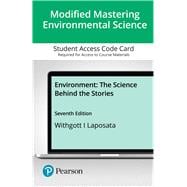For courses in introductory environmental science.
This ISBN is for the Modified Mastering access card. Pearson eText is included.
See the data, connections, and solutions behind environmental issues
Environment: The Science behind the Stories is known for its friendly narrative style, its integration of real stories and case studies, and its presentation of the latest science and research. With the 7th Edition, engaging new features open learners’ eyes to environmental issues, making it easy to see the data with new infographic-style illustrations, see the connections between the case studies and their own lives with new local connections activities, and see potential solutions with new success stories features. The new edition provides new levels of integration between the text, Mastering, and Pearson eText with digital components built into every hallmark feature, giving learners seamless access to the tools and resources they need to succeed.
Personalize learning with Mastering Environmental Science
By combining trusted author content with digital tools and a flexible platform, Mastering personalizes the learning experience and improves results for each student. Mastering Environmental Science extends learning and provides students with a platform to practice, learn, and apply knowledge outside of the classroom.
You are purchasing an access card only. Before purchasing, check with your instructor to confirm the correct ISBN. Several versions of the MyLab™ and Mastering™ platforms exist for each title, and registrations are not transferable. To register for and use MyLab or Mastering, you may also need a Course ID, which your instructor will provide.
If purchasing or renting from companies other than Pearson, the access codes for the Mastering platform may not be included, may be incorrect, or may be previously redeemed. Check with the seller before completing your purchase.











